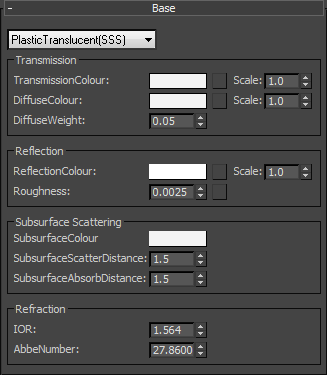
Documentation

Documentation
This is a full-featured subsurface scattering component (see DiffuseSSS for a simplified version). This component produces a more realistic subsurface scattering effect than other components, but this comes at the expense of rendering speed. All light in your scene will penetrate the object and you will be able to see objects through, and behind the material.

Controls the Color of the transmitted light.
Input: Color
First color in above swatches are TransmissionColor, second is DiffuseColor. Click material thumbnail for larger view
The basic surface color of the component, this is controlled by the DiffuseWeight parameter. This can be a single Color value or a texture map.
Input: Map/Color
Controls the balance between the diffuse surface texturing and the more complex subsurface scattering effect. Increasing the value will reduce the contribution of subsurface scattering.
Range: 0.0 - 1.0
Click material thumbnail for larger view
Controls the color of the glossy highlights on the material. This can be a single color value or a texture map.
Input: Map/Color
Click material thumbnail for larger view
Controls the size of the glossy highlights. Higher values will make reflections appear more blurred.
Range: 0.0 - 1.0
Click material thumbnail for larger view
Controls the color of the inside of the material. Light passing through will gradually be absorbed based on this color. The thicker the object, the more light will be absorbed. A pure white color means there will be no absorption, a pure black color means all light is absorbed as soon as it enters the material. This must be a single color value, it cannot be a texture map or noise function.
Input: Color
First color in above swatches are SubsurfaceColor, second is TransmissionColor. Click material thumbnail for larger view
This scale, in metres, controls the overall strength of the subsurface scattering effect. Reducing this parameter will strengthen the effect. On average, light passing through the material will undergo scattering each time it travels this distance through the material. Note that the useful range for this parameter is between one-tenth and ten times the size of the object the material is applied to. Setting a value outside of this range will make little or no difference to the material's appearance.
Range: 0.0 -
Click material thumbnail for larger view
This scale, in metres, controls the overall strength of the subsurface absorption effect. Reducing this parameter will strengthen the effect. On average, light passing through the material will be attenuated by the SubsurfaceColour each time it travels this distance through the material.
Range: 0.0 -
Click material thumbnail for larger view
The index of refraction of the material.
Range: 0.0 -
Click material thumbnail for larger view
This controls the spectral dispersion effect. Set it to zero to disable spectral dispersion. A non-zero value will enable dispersion, with the strength of the dispersion effect depending on the Abbe number in a physically realistic way. A low Abbe number leads to strong dispersion, a high Abbe number leads to weak dispersion. Types of glass are often classified according to their Abbe number - typical values range from 20 up to 85.
Range: 0.0 -
Base
Click material thumbnail for larger view
▲Page Last Edited: